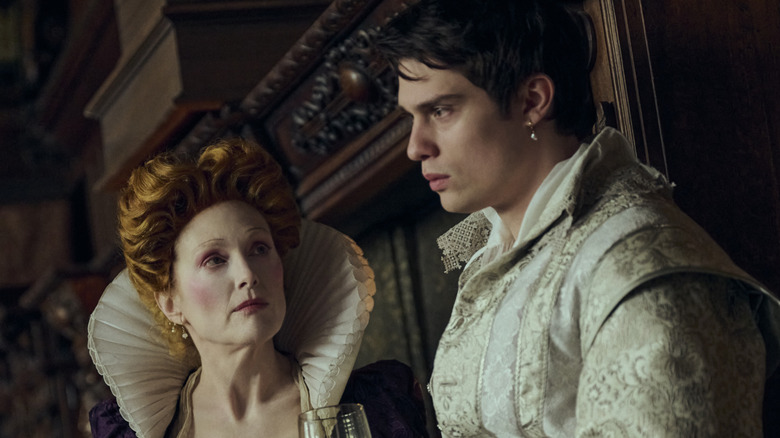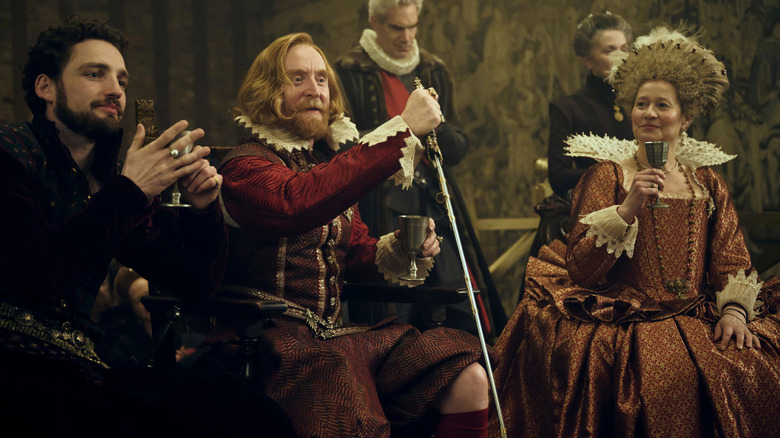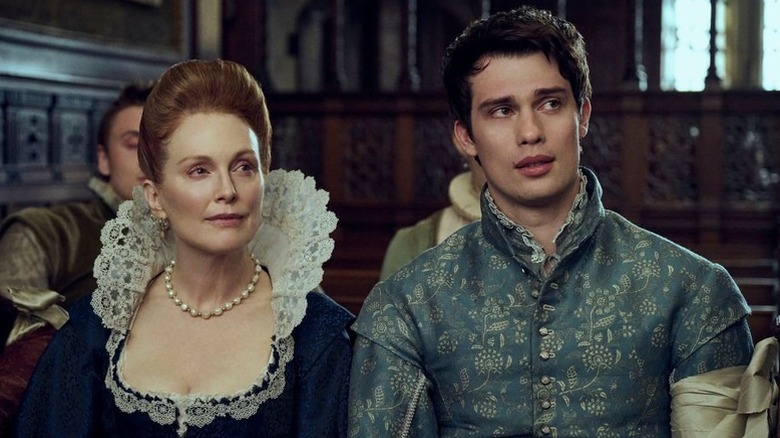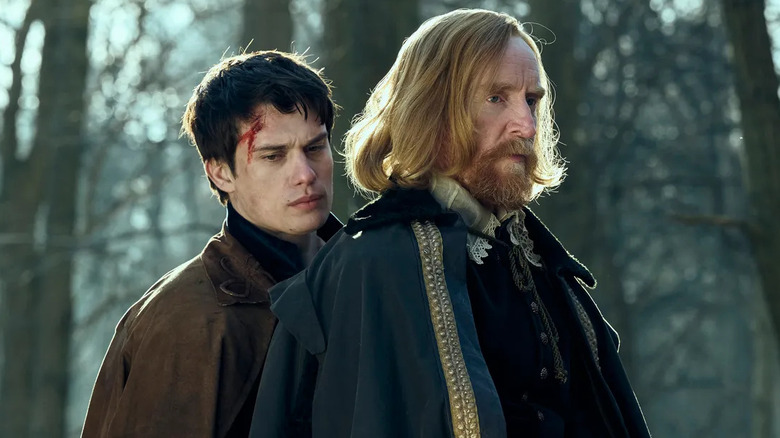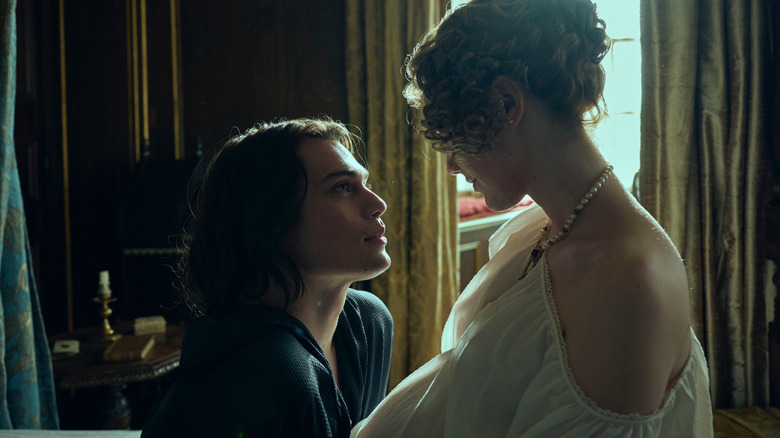The True Story Behind Mary & George Explained
Debuting on Starz in early 2024, "Mary & George" isn't a sitcom about a quirky young married couple, but the true story of Mary Villiers and her son George, a pair of commoners who wormed their way into royal society in England in the 17th century. In the series, we meet George (Nicholas Galitzine, who has conflicted feelings over gay roles) and learn about his troubled childhood and how his mother Mary (Julianne Moore) raises him in hopes of using him as part of an elaborate scheme to earn her wealth and power.
Plotting to get close to King James I (Tony Curran), Mary manipulates the monarch to fall in love with George, aware of the king's physical relationships with his closest male advisors. To get what she wants, though, she'll have to force out the king's current consort, the Earl of Somerset (Laurie Davidson), and get her son noticed by the royal court. She may also have to resort to more terrifying means, using the power of sex — and several murder plots — to achieve her aims.
But how real is "Mary & George"? The relationship between the real King James and George Villiers has been disputed for centuries. Though its romantic nature is hard to deny, there's no direct evidence that it was sexual. The real Mary Villiers, meanwhile, may or may not have been as manipulative as the series suggests, with contemporary accounts and modern day historians often debating George's rise from commoner to king's favorite. Let's try to parse fact from fiction and figure out the true story behind "Mary & George."
King James had a traumatic upbringing
As "Mary & George" shows, George Villiers wasn't the first male confidante of King James I, and certainly not the first to meet the approval of the monarch's gaze. Before George — who James lovingly referred to (via the BBC) as his "sweet child and wife" — it was the 1st Earl of Somerset, Robert Carr. But while many may see the King's borderline romance with his male advisors as a sign of repressed sexuality, some historians have posited that there may be an underlying reason that James sought out such companions — a traumatic childhood that left him with a need for male attention and aid to help stabilize him.
James' father was the victim of a murder plot shortly after he was born. Less than a year later, the infant became King James at the tender age of 13 months, after his mother the queen had abdicated the throne. During his formative years, James was the target of multiple assassination attempts and internal coups, leaving him with a series of regents that came and went with regularity. One of his closest, the Earl of Moray, was the victim of a roadside ambush in 1570.
With so much uncertainty and a clear absence of consistent parental figures, it's no wonder that King James I sought out male advisors he could trust. As King, it makes sense that he would elevate those who he became enamored with to higher positions by his side, even apart from any romantic affections.
Mary was a master manipulator of power
In the opening episode of "Mary & George," the younger Villiers nearly ends his own life rather than submit to his mother's scheming ways. Mary is obsessed with using her son to attain power and wealth, and over the course of the series, she achieves her goals: George becomes close to King James I and is brought into his inner circle, with Mary given enormous powers too. This is all fairly true to history: King James held a fierce loyalty to the Villiers family, once proudly stating (via "The Stuarts" by J.P. Kenyon), his "desire to advance [the Villiers] above all others."
Mary's quest to use her son to gain influence in the King's court wasn't some half-hearted notion or spur-of-the-moment plot brought on by happenstance. In fact, it was long her plan to use her children as a means to her own ends. Mary and her two sons were impoverished, and while she could have tried to groom her firstborn son to get them out of poverty, it was George who she saw had greater potential due to his good looks.
Knowing she'd need to prepare George for high society, Mary entered into a second marriage solely for its monetary benefit. Thus she was able to send George to France to learn dancing, etiquette, and a second language. This new refinement, plus his dashing good looks and fine physical form, helped earn him notice during his first encounter with the English king.
Did George and James have a romantic relationship?
The first meeting between King James and George Villiers occurred in a very different manner than portrayed in the opening episode of "Mary & George." In the series, King James visits the home of George's mother, and not long after, they arrange for the younger Villiers to help service a dinner for the King. In reality, James and George's first encounter actually took place during a hunt in the Northamptonshire village of Apethorpe (which is depicted in the show's second episode as their second meeting). George was there as a member of the entourage of the former ambassador to France, Anthony Mildmay, whose land they used for the hunt.
During the meeting, King James was impressed (some say charmed) by Villiers and soon brought him to his court as Royal Cup bearer. The two bonded quickly, and before long, Villiers was often known to entertain the King with his fanciful stories, crackling wit, and of course his dancing skills, much to the monarch's delight. Their relationship was far more than professional, however, with real romantic overtones.
Perhaps surprisingly, their romantic affection wasn't really a secret — or if it was, it was a very open secret, as they were seen locking lips by many. In fact, one notable contemporary, Francis Osborne, reportedly witnessed them kissing so intensely that he wondered what else was going on behind closed doors. Nevertheless, historians have long debated whether the two shared a sexual relationship, even if their romantic love was on full display.
Mary schemed to discredit a woman into marrying her son
The ascent of George Villiers was one of the most astonishing in royal history. In just a few short years, the young man went from commoner to cup boy, then from court advisor to the Duke of Buckingham. But George wasn't the only one to benefit from his meteoric rise: Just as his mother planned, she too was able to worm herself into the king's inner circle, enough that James began treating her similarly, even granting her powers and influence in the English court. Eventually, he'd name her the Countess of Buckingham.
Even given a title of her own, Mary wasn't content to simply sit back and enjoy the fruits of her efforts. As some historians have suggested, Mary spearheaded yet another scheme to gain further power and influence, setting out to find a good bride for her son. Her pick was Lady Katherine Manners (played in the series by "The Witcher: Blood Origin" cast member Mirren Mack), a wealthy aristocrat and heiress. While to most it may have seemed like an ordinary royal courtship, some of their contemporaries believed that Mary had actually trapped Katherine into marrying George. Mary purportedly forced Katherine to spend the night with her son, creating a potential scandal if she didn't marry him.
Mary's careful curation of the people in her family's life extended to the king, and continued until his death: When King James fell seriously ill in 1625, Mary argued with doctors over the preferred treatment.
George remained a powerful but reviled figure for years
At the climax of the final episode of "Mary & George," the younger Villiers murders the King after he declares their love meaningless. This is far from accurate to the historical record, which reveals that King James died in 1625 after suffering a series of ailments including malarial fever, dysentery, and eventually a stroke. Some historians have speculated that he was poisoned by George, but those theories are largely discredited, though many believed them even at the time.
George continued to maintain influence in the royal court after James' death, even as the crown passed to James' son Charles. George remained the closest advisor to the crown, aiding King Charles I just as he did his father. But George was not well-liked, particularly with the public, who viewed him as a scandalous figure. He eventually met his death at the end of a knife wielded by the assassin John Felton, who felt he was doing the nation a favor — and few mourned his passing, with open celebrations breaking out across London. In fact, Villiers was so reviled by the people for his warmongering that his funeral was arranged to be held under the cover of darkness.
